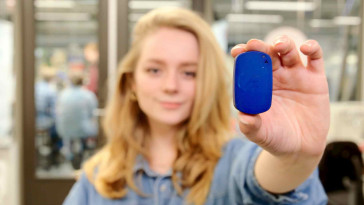Samenvatting Achtergrond: Een integrale behandeling inclusief zelfmanagement bij chronisch obstructieve longziekte (COPD) leidt tot betere klinische resultaten. eHealth kan zorgen voor meer betrokkenheid bij patiënten waardoor ze in staat zijn een gezondere levensstijl aan te nemen en vast te houden. Desondanks is er geen eenduidig bewijs van de impact van eHealth op de kwaliteit van leven (quality of life (QoL)). Doel: Het primaire doel van de e-Vita COPD-studie was om te onderzoeken wat de effecten zijn van het gebruik van eeneHealth-platform voor patiënten op de verschillende domeinen van ziektespecifieke kwaliteit van leven van COPD-patiënten (CCQ). Methoden: We hebben de impact beoordeeld van het gebruik van een eHealth-platform op de klinische COPD-vragenlijst (CCQ). Deze vragenlijst omvatte subschalen van symptomen, functionele en mentale toestand. Een design met onderbroken tijdreeksen (interrupted time series (ITS)) is gebruikt om CCQ-gegevens op verschillende tijdstippen te verzamelen. Er is gebruik gemaakt van multilevel lineaire regressieanalyse om de CCQ-trends vóór en na de interventie te vergelijken. Resultaten: Van de 742 uitgenodigde COPD-patiënten hebben er 244 het document voor ‘informed consent’ ondertekend. In de analyses hebben we uitsluitend patiënten opgenomen die daadwerkelijk gebruik hebben gemaakt van het eHealthplatform (n=123). De afname van CCQ-symptomen was 0,20% vóór de interventie en 0,27% na de interventie; dit was een statistisch significant verschil (P=0,027). De daling van CCQ-mentale toestand was 0,97% vóór de interventie en na de interventie was er sprake van een stijging van 0,017%; dit verschil was statistisch significant (P=0,01). Er werd geen significant verschil vastgesteld in het verloop van CCQ (P=0,12) en CCQ-functionele toestand (P=0,11) vóór en na de interventie. Conclusie: Het e-Vita eHealth-platform had een gunstig effect op de CCQ-symptomen van COPD-patiënten, maar niet op de functionele status. De CCQ-mentale toestand bleef stabiel na de interventie, maar dit was een verslechtering in vergelijking met de verbeterende situatie voorafgaand aan de start van het eHealth-platform. Deze studie laat dus zien dat patiënten na de introductie van het COPD-platform minder symptomen ervaarden, maar dat hun mentale toestand tegelijkertijd licht verslechterde. Zorgprofessionals moeten zich ervan bewust zijn dat, ondanks de verbetering van symptomen, er een lichte toename van angst en depressie kan optreden na invoering van een eHealth-interventie.
DOCUMENT

In the Netherlands an innovative programme for early detection of chronic obstructive pulmonary disease (COPD) in primary care among patients aged 40–70 years has been evaluated in both an effect study and a pilot implementation study. Health-care providers identified four obstacles for successful implementation of a COPD early detection programme. This Brief Communication describes the most important results of a qualitative study using in-depth interviews.
DOCUMENT

A loss of physical functioning (i.e., a low physical capacity and/or a low physical activity) is a common feature in patients with chronic obstructive pulmonary disease (COPD). To date, the primary care physiotherapy and specialized pulmonary rehabilitation are clearly underused, and limited to patients with a moderate to very severe degree of airflow limitation (GOLD stage 2 or higher). However, improved referral rates are a necessity to lower the burden for patients with COPD and for society. Therefore, a multidisciplinary group of healthcare professionals and scientists proposes a new model for referral of patients with COPD to the right type of exercise-based care, irrespective of the degree of airflow limitation. Indeed, disease instability (recent hospitalization, yes/no), the burden of disease (no/low, mild/moderate or high), physical capacity (low or preserved) and physical activity (low or preserved) need to be used to allocate patients to one of the six distinct patient profiles. Patients with profile 1 or 2 will not be referred for physiotherapy; patients with profiles 3–5 will be referred for primary care physiotherapy; and patients with profile 6 will be referred for screening for specialized pulmonary rehabilitation. The proposed Dutch model has the intention to get the right patient with COPD allocated to the right type of exercise-based care and at the right moment.
DOCUMENT

Data is het nieuwe goud, en de vraag naar data is nooit zo groot geweest. Zo ook data over de mens en zijn leefomgeving. Maar om voor elke vraag een specifieke sensor te maken is kostbaar. Er moet één sensor komen die al die situaties nauwkeurig kan meten.

Copiloot voor COPD is een app voor mensen met COPD die hen ondersteunt bij zelfmanagement. Copiloot helpt hen symptomen te monitoren en verandering te signaleren. Met een persoonlijk longaanval-actieplan worden zij geholpen bij het nemen van de juiste beslissing op het juiste moment: learning by doing.

Aanleiding De wereld van de zorgprofessional verandert in hoog tempo door de opkomst van technologie. Technologieën kunnen de traditionele behandelmethoden ondersteunen. Het probleem is echter dat een goed overzicht van de mogelijkheden ontbreekt. Een groep fysio- en ergotherapeuten wil graag gebruik gaan maken van draagbare technologie om beweegactiviteiten bij cliënten te meten (activiteitenmeters). Er is een gevarieerd aanbod aan betaalbare activiteitenmeters op de markt dat buiten de zorg al veelvuldig wordt gebruikt. De zorgprofessionals willen weten welke meter(s) zij het beste kunnen kiezen en op basis van welke criteria. Doelstelling Het RAAK-project wil de eisen die zorgprofessionals en cliënten stellen aan draagbare technologie voor het meten van beweegactiviteiten in kaart brengen. Het onderzoek geeft antwoord op de vraag hoe fysio- en ergotherapeuten de activiteitenmeters in de zorg kunnen toepassen. Onderzoekers beoordelen de hanteerbaarheid, toepasbaarheid en betrouwbaarheid van activiteitenmeters. Een aantal geselecteerde activiteitenmeters wordt in de praktijk getest bij cliënten met een chronische aandoening. De opgedane kennis wordt gebruikt om criteria op te stellen en een keuzehulp te maken voor zowel zorgprofessionals als cliënten. Beoogde resultaten Zorgverleners en cliënten zijn na afloop van het project in staat om een gefundeerde keuze te maken voor een activiteitenmeter en weten hoe zij deze kunnen toepassen. Het project heeft daarvoor concrete middelen opgeleverd: een keuzehulp om activiteitenmeters te selecteren (afhankelijk van het gebruikersdoel) en een methodiek voor het adviseren van draagbare technologie. De opgestelde criteria geven richting aan de ontwikkeling van nieuwe activiteitenmeters. De opgedane kennis wordt gedeeld met het onderwijs en werkveld. Op de bestaande websites www.meetinstrumentenzorg.nl en www.qsinstitute.org zal de keuzehulp te vinden zijn.